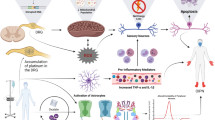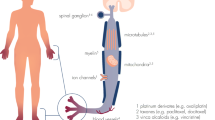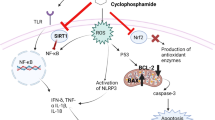Abstract
Chemotherapy-induced peripheral neuropathy (CIPN) is a common side effect of anticancer treatment with microtubule-targeted agents (MTAs). The frequency of severe CIPN, which can be dose limiting and even life threatening, varies widely among different MTAs. For example, paclitaxel induces a higher frequency of severe CIPN than does eribulin. Different MTAs also possess distinct mechanisms of microtubule-targeted action. Recently, we demonstrated that paclitaxel and eribulin differentially affect sciatic nerve axons, with paclitaxel inducing more pronounced neurodegenerative effects and eribulin inducing greater microtubule stabilizing biochemical effects. Here, we complement and extend these axonal studies by assessing the effects of paclitaxel and eribulin in the cell bodies of sciatic nerve axons, housed in the dorsal root ganglia (DRG). Importantly, the microtubule network in cell bodies is known to be significantly more dynamic than in axons. Paclitaxel induced activating transcription factor 3 expression, a marker of neuronal stress/injury. Paclitaxel also increased expression levels of acetylated tubulin and end binding protein 1, markers of microtubule stability and growth, respectively. These effects are hypothesized to be detrimental to the dynamic microtubule network within the cell bodies. In contrast, eribulin had no significant effect on any of these parameters in the cell bodies. Taken together, DRG cell bodies and their axons, two distinct neuronal cell compartments, contain functionally distinct microtubule networks that exhibit unique biochemical responses to different MTA treatments. We hypothesize that these distinct mechanistic actions may underlie the variability seen in the initiation, progression, persistence, and recovery from CIPN.





Similar content being viewed by others
References
Akhmanova A, Steinmetz MO (2015) Control of microtubule organization and dynamics: two ends in the limelight. Nat Rev Mol Cell Biol 16:711–726. doi:10.1038/nrm4084
Argyriou AA, Bruna J, Marmiroli P, Cavaletti G (2012) Chemotherapy-induced peripheral neurotoxicity (CIPN): an update. Crit Rev Oncol Hematol 82:51–77. doi:10.1016/j.critrevonc.2011.04.012
Argyriou AA, Kyritsis AP, Makatsoris T, Kalofonos HP (2014) Chemotherapy-induced peripheral neuropathy in adults: a comprehensive update of the literature. Cancer Manag Res 6:135–147. doi:10.2147/cmar.s44261
Benbow SJ, Cook BM, Reifert J, Wozniak KM, Slusher BS, Littlefield BA, Wilson L, Jordan MA, Feinstein SC (2016) Effects of paclitaxel and eribulin in mouse sciatic nerve: a microtubule-based rationale for the differential induction of chemotherapy-induced peripheral neuropathy. Neurotox Res 29:299–313. doi:10.1007/s12640-015-9580-6
Bhattacharya R, Yang H, Cabral F (2011) Class V beta-tubulin alters dynamic instability and stimulates microtubule detachment from centrosomes. Mol Biol Cell 22:1025–1034. doi:10.1091/mbc.E10-10-0822
Black MM, Keyser P (1987) Acetylation of alpha-tubulin in cultured neurons and the induction of alpha-tubulin acetylation in PC12 cells by treatment with nerve growth factor. J Neurosci 7:1833–1842
Bristol-Myers-Squibb (2011) Taxol (paclitaxel) injection [Package Insert]. Princeton, NJ
Bunker JM, Wilson L, Jordan MA, Feinstein SC (2004) Modulation of microtubule dynamics by tau in living cells: implications for development and neurodegeneration. Mol Biol Cell 15:2720–2728. doi:10.1091/mbc.E04-01-0062
Carlson K, Ocean AJ (2011) Peripheral neuropathy with microtubule-targeting agents: occurrence and management approach. Clin Breast Cancer 11:73–81. doi:10.1016/j.clbc.2011.03.006
Carozzi VA, Renn CL, Bardini M, Fazio G, Chiorazzi A, Meregalli C, Oggioni N, Shanks K, Quartu M, Serra MP, Sala B, Cavaletti G, Dorsey SG (2013) Bortezomib-induced painful peripheral neuropathy: an electrophysiological, behavioral, morphological and mechanistic study in the mouse. PLoS One 8:e72995. doi:10.1371/journal.pone.0072995
Choi YJ, Di Nardo A, Kramvis I, Meikle L, Kwiatkowski DJ, Sahin M, He X (2008) Tuberous sclerosis complex proteins control axon formation. Genes Dev 22:2485–2495
Cortes J, Montero AJ, Glück S (2012) Eribulin mesylate, a novel microtubule inhibitor in the treatment of breast cancer. Cancer Treat Rev 38(2):143–151
Creppe C, Malinouskaya L, Volvert ML, Gillard M, Close P, Malaise O, Laguesse S, Cornez I, Rahmouni S, Ormenese S, Belachew S, Malgrange B, Chapelle JP, Siebenlist U, Moonen G, Chariot A, Nguyen L (2009) Elongator controls the migration and differentiation of cortical neurons through acetylation of alpha-tubulin. Cell 136:551–564. doi:10.1016/j.cell.2008.11.043
Derry WB, Wilson L, Jordan MA (1995) Substoichiometric binding of taxol suppresses microtubule dynamics. Biochemistry 34:2203–2211
Dompierre JP, Godin JD, Charrin BC, Cordelieres FP, King SJ, Humbert S, Saudou F (2007) Histone deacetylase 6 inhibition compensates for the transport deficit in Huntington’s disease by increasing tubulin acetylation. J Neurosci 27:3571–3583. doi:10.1523/jneurosci.0037-07.2007
Eisai-Inc. (2016) Halaven [Package insert] highlights of prescribing information. Woodcliff Lake, NJ
Fehrenbacher JC (2015) Chemotherapy-induced peripheral neuropathy. Prog Mol Biol Transl Sci 131:471–508. doi:10.1016/bs.pmbts.2014.12.002
Field JJ, Kanakkanthara A, Miller JH (2014) Microtubule-targeting agents are clinically successful due to both mitotic and interphase impairment of microtubule function. Bioorg Med Chem 22:5050–5059. doi:10.1016/j.bmc.2014.02.035
Geraldo S, Khanzada UK, Parsons M, Chilton JK, Gordon-Weeks PR (2008) Targeting of the F-actin-binding protein drebrin by the microtubule plus-tip protein EB3 is required for neuritogenesis. Nat Cell Biol 10:1181–1189. doi:10.1038/ncb1778
Giannakakou P, Nakano M, Nicolaou KC, O'Brate A, Yu J, Blagosklonny MV, Greber UF, Fojo T (2002) Enhanced microtubule-dependent trafficking and p53 nuclear accumulation by suppression of microtubule dynamics. Proc Natl Acad Sci U S A 99:10855–10860. doi:10.1073/pnas.132275599
Godena VK, Brookes-Hocking N, Moller A, Shaw G, Oswald M, Sancho RM, Miller CC, Whitworth AJ, De Vos KJ (2014) Increasing microtubule acetylation rescues axonal transport and locomotor deficits caused by LRRK2 Roc-COR domain mutations. Nat Commun 5:5245. doi:10.1038/ncomms6245
Gradishar WJ (2011) The place for eribulin in the treatment of metastatic breast cancer. Curr Oncol Rep 13:11–16. doi:10.1007/s11912-010-0145-9
Grisold W, Cavaletti G, Windebank AJ (2012) Peripheral neuropathies from chemotherapeutics and targeted agents: diagnosis, treatment, and prevention. Neuro-Oncology 14(Suppl 4):iv45–iv54. doi:10.1093/neuonc/nos203
Gu C, Zhou W, Puthenveedu MA, Xu M, Jan YN, Jan LY (2006) The microtubule plus-end tracking protein EB1 is required for Kv1 voltage-gated K+ channel axonal targeting. Neuron 52:803–816. doi:10.1016/j.neuron.2006.10.022
Gundersen GG, Khawaja S, Bulinski JC (1987) Postpolymerization detyrosination of alpha-tubulin: a mechanism for subcellular differentiation of microtubules. J Cell Biol 105:251–264
Janes K, Little JW, Li C, Bryant L, Chen C, Chen Z, Kamocki K, Doyle T, Snider A, Esposito E, Cuzzocrea S, Bieberich E, Obeid L, Petrache I, Nicol G, Neumann WL, Salvemini D (2014) The development and maintenance of paclitaxel-induced neuropathic pain require activation of the sphingosine 1-phosphate receptor subtype 1. J Biol Chem 289:21082–21097. doi:10.1074/jbc.M114.569574
Janke C (2014) The tubulin code: molecular components, readout mechanisms, and functions. J Cell Biol 206:461–472. doi:10.1083/jcb.201406055
Janke C, Bulinski JC (2011) Post-translational regulation of the microtubule cytoskeleton: mechanisms and functions. Nat Rev Mol Cell Biol 12:773–786. doi:10.1038/nrm3227
Janke C, Kneussel M (2010) Tubulin post-translational modifications: encoding functions on the neuronal microtubule cytoskeleton. Trends Neurosci 33:362–372. doi:10.1016/j.tins.2010.05.001
Jaworski J, Kapitein LC, Gouveia SM, Dortland BR, Wulf PS, Grigoriev I, Camera P, Spangler SA, Di Stefano P, Demmers J, Krugers H, Defilippi P, Akhmanova A, Hoogenraad CC (2009) Dynamic microtubules regulate dendritic spine morphology and synaptic plasticity. Neuron 61:85–100. doi:10.1016/j.neuron.2008.11.013
Jordan MA, Wilson L (2004) Microtubules as a target for anticancer drugs. Nat Rev Cancer 4:253–265. doi:10.1038/nrc1317
Jordan MA, Kamath K, Manna T, Okouneva T, Miller HP, Davis C, Littlefield BA, Wilson L (2005) The primary antimitotic mechanism of action of the synthetic halichondrin E7389 is suppression of microtubule growth. Mol Cancer Ther 4:1086–1095. doi:10.1158/1535-7163.mct-04-0345
Kamath K, Wilson L, Cabral F, Jordan MA (2005) BetaIII-tubulin induces paclitaxel resistance in association with reduced effects on microtubule dynamic instability. J Biol Chem 280:12902–12907. doi:10.1074/jbc.M414477200
Lapointe NE, Morfini G, Brady ST, Feinstein SC, Wilson L, Jordan M (2013) Effects of eribulin, vincristine, paclitaxel and ixabepilone on fast axonal transport and kinesin-1 driven microtubule gliding: implications for chemotherapy-induced peripheral neuropathy. Neurotoxicology. doi:10.1016/j.neuro.2013.05.008
Levy DB, Smith KJ, Beazer-Barclay Y, Hamilton SR, Vogelstein B, Kinzler KW (1994) Inactivation of both APC alleles in human and mouse tumors. Cancer Res 54:5953–5958
Lu Q, Luduena RF (1993) Removal of beta III isotype enhances taxol induced microtubule assembly. Cell Struct Funct 18:173–182
Maurer SP, Fourniol FJ, Bohner G, Moores CA, Surrey T (2012) EBs recognize a nucleotide-dependent structural cap at growing microtubule ends. Cell 149:371–382. doi:10.1016/j.cell.2012.02.049
Morfini GA, Burns M, Binder LI, Kanaan NM, LaPointe N, Bosco DA, Brown RH Jr, Brown H, Tiwari A, Hayward L, Edgar J, Nave KA, Garberrn J, Atagi Y, Song Y, Pigino G, Brady ST (2009) Axonal transport defects in neurodegenerative diseases. J Neurosci 29:12776–12786. doi:10.1523/jneurosci.3463-09.2009
Peters CM, Jimenez-Andrade JM, Jonas BM, Sevcik MA, Koewler NJ, Ghilardi JR, Wong GY, Mantyh PW (2007a) Intravenous paclitaxel administration in the rat induces a peripheral sensory neuropathy characterized by macrophage infiltration and injury to sensory neurons and their supporting cells. Exp Neurol 203:42–54. doi:10.1016/j.expneurol.2006.07.022
Peters CM, Jimenez-Andrade JM, Kuskowski MA, Ghilardi JR, Mantyh PW (2007b) An evolving cellular pathology occurs in dorsal root ganglia, peripheral nerve and spinal cord following intravenous administration of paclitaxel in the rat. Brain Res 1168:46–59. doi:10.1016/j.brainres.2007.06.066
Poruchynsky MS, Komlodi-Pasztor E, Trostel S, Wilkerson J, Regairaz M, Pommier Y, Zhang X, Kumar Maity T, Robey R, Burotto M, Sackett D, Guha U, Fojo AT (2015) Microtubule-targeting agents augment the toxicity of DNA-damaging agents by disrupting intracellular trafficking of DNA repair proteins. Proc Natl Acad Sci U S A 112:1571–1576. doi:10.1073/pnas.1416418112
Ranganathan S, Dexter DW, Benetatos CA, Chapman AE, Tew KD, Hudes GR (1996) Increase of beta(III)- and beta(IVa)-tubulin isotopes in human prostate carcinoma cells as a result of estramustine resistance. Cancer Res 56:2584–2589
Rinkevich Y, Montoro DT, Muhonen E, Walmsley GG, Lo D, Hasegawa M, Januszyk M, Connolly AJ, Weissman IL, Longaker MT (2014) Clonal analysis reveals nerve-dependent and independent roles on mammalian hind limb tissue maintenance and regeneration. Proc Natl Acad Sci U S A 111:9846–9851. doi:10.1073/pnas.1410097111
Rotshenker S (2011) Wallerian degeneration: the innate-immune response to traumatic nerve injury. J Neuroinflammation 8:109. doi:10.1186/1742-2094-8-109
Savage C, Hamelin M, Culotti JG, Coulson A, Albertson DG, Chalfie M (1989) mec-7 is a beta-tubulin gene required for the production of 15-protofilament microtubules in Caenorhabditis elegans. Genes Dev 3:870–881
Smith JA, Wilson L, Azarenko O, Zhu X, Lewis BM, Littlefield BA, Jordan MA (2010) Eribulin binds at microtubule ends to a single site on tubulin to suppress dynamic instability. Biochemistry 49:1331–1337. doi:10.1021/bi901810u
Smith JA, Slusher BS, Wozniak KM, Farah MH, Smiyun G, Wilson L, Feinstein S, Jordan MA (2016) Structural basis for induction of peripheral neuropathy by microtubule-targeting cancer drugs. Cancer Res. doi:10.1158/0008-5472.can-15-3116
Song Y, Brady ST (2015) Post-translational modifications of tubulin: pathways to functional diversity of microtubules. Trends Cell Biol 25:125–136. doi:10.1016/j.tcb.2014.10.004
Towle MJ, Salvato KA, Budrow J, Wels BF, Kuznetsov G, Aalfs KK, Welsh S, Zheng W, Seletsky BM, Palme MH, Habgood GJ, Singer LA, Dipietro LV, Wang Y, Chen JJ, Quincy DA, Davis A, Yoshimatsu K, Kishi Y, Yu MJ, Littlefield BA (2001) In vitro and in vivo anticancer activities of synthetic macrocyclic ketone analogues of halichondrin B. Cancer Res 61:1013–1021
Tsujino H, Kondo E, Fukuoka T, Dai Y, Tokunaga A, Miki K, Yonenobu K, Ochi T, Noguchi K (2000) Activating transcription factor 3 (ATF3) induction by axotomy in sensory and motoneurons: a novel neuronal marker of nerve injury. Mol Cell Neurosci 15:170–182. doi:10.1006/mcne.1999.0814
Vitre B, Coquelle FM, Heichette C, Garnier C, Chretien D, Arnal I (2008) EB1 regulates microtubule dynamics and tubulin sheet closure in vitro. Nat Cell Biol 10:415–421. doi:10.1038/ncb1703
Webster DR, Borisy GG (1989) Microtubules are acetylated in domains that turn over slowly. J Cell Sci 92(Pt 1):57–65
Windebank AJ, Grisold W (2008) Chemotherapy-induced neuropathy. J Peripher Nerv Syst 13:27–46. doi:10.1111/j.1529-8027.2008.00156.x
Wozniak KM, Nomoto K, Lapidus RG, Wu Y, Carozzi V, Cavaletti G, Hayakawa K, Hosokawa S, Towle MJ, Littlefield BA, Slusher BS (2011) Comparison of neuropathy-inducing effects of eribulin mesylate, paclitaxel, and ixabepilone in mice. Cancer Res 71:3952–3962. doi:10.1158/0008-5472.can-10-4184
Wozniak KM, Vornov JJ, Wu Y, Nomoto K, Littlefield BA, DesJardins C, Yu Y, Lai G, Reyderman L, Wong N, Slusher BS (2016) Sustained accumulation of microtubule-binding chemotherapy drugs in the peripheral nervous system: correlations with time course and neurotoxic severity. Cancer Res 76:3332–3339. doi:10.1158/0008-5472.can-15-2525
Zhang T, Yao S, Wang P, Yin C, Xiao C, Qian M, Liu D, Zheng L, Meng W, Zhu H, Liu J, Xu H, Mo X (2011) ApoA-II directs morphogenetic movements of zebrafish embryo by preventing chromosome fusion during nuclear division in yolk syncytial layer. J Biol Chem 286:9514–9525. doi:10.1074/jbc.M110.134908
Zhang H, Li Y, de Carvalho-Barbosa M, Kavelaars A, Heijnen CJ, Albrecht PJ, Dougherty PM (2016) Dorsal root ganglion infiltration by macrophages contributes to paclitaxel chemotherapy induced peripheral neuropathy. J Pain. doi:10.1016/j.jpain.2016.02.011
Acknowledgements
We are grateful to Nichole LaPointe, Brett Cook, Benjamin Reese, Patrick Keeley, Jennifer Smith, and Mary Raven for valuable discussions and to Benjamin Reese for sharing equipment with us. We also acknowledge the use of instruments in the NRI-MCDB Microscopy Facility at UCSB (supported in part by the Office of The Director, National Institutes of Health of the NIH under Award # S10OD010610). This work was supported by grants from EISAI (to SCF, BSS, MAJ, and LW) and the NIH/NCI (R01CA161056) to BSS.
Author information
Authors and Affiliations
Corresponding author
Ethics declarations
All experimental protocols were approved by the Institutional Animal Care and Use Committee of Johns Hopkins and adhered to all of the applicable institutional and governmental guidelines for the humane treatment of laboratory animals.
Electronic Supplementary Material
Supplemental figure 1
Image set example. Each image set contains one section from each treatment condition incubated with the same antibody dilution and imaged using the same acquisition settings. VehPac = Vehicle for paclitaxel, Pac = paclitaxel, Veherb = Vehicle for eribulin, and Erb = eribulin. (GIF 150 kb).
Supplemental figure 2
Separation of neuronal cell bodies from non-neuronal cells within sectioned DRG tissue. a Representative stained DRG tissue section. Merged channel image containing Cy2 (e.g., α-tubulin, green) and βIII-tubulin (red) signals. b Cy2 channel (green, used for several proteins of interest throughout this study). c βIII-tubulin signal used as a marker for neuronal cells (cy3 channel, red). d Manually defined region of interest to separate DRG tissue from axonal tissue within a section. e Merged (cy2 (green, and βIII-tubulin (red))) image showing the identification of βIII-tubulin positive regions (grey) separating neuronal cell bodies from non-neuronal cells within the manually defined region shown in (d). f Single βIII-tubulin channel image showing the identification of βIII-tubulin positive regions (grey) separating neuronal cell bodies from non-neuronal cells as in (e) within the manually defined region shown in (d). Mean fluorescent signal for a given section were calculated using the measurements of cy2 or cy3 signal within each βIII-tubulin positive volumetric pixel as denoted by grey ROIs in (e) and (f). Scale bar 50 μm. (GIF 109 kb).
Supplemental figure 3
Normalization procedure enabling comparison between image sets. a Each image set contained a section from each of the treatment groups stained with the same antibody dilution and imaged using identical acquisition parameters. The mean fluorescence for each section, termed the “treatment mean”, (a.1-a.4) by averaging cy2 (green) fluorescent signal for βIII-tubulin positive volumetric regions (grey in images a.5-a.8). b Fluorescent signal readings in βIII-tubulin positive volumetric regions (green circles) are averaged resulting in the “treatment mean”. In order to compare across image sets of sections means were normalized within the respective image set prior to cross-set comparison, resulting in normalized treatment means. Means are normalized by dividing the treatment mean by the sum of means within the image set. The normalized treatment means were used to compose the graphs in the main text. (GIF 165 kb).
Rights and permissions
About this article
Cite this article
Benbow, S.J., Wozniak, K.M., Kulesh, B. et al. Microtubule-Targeting Agents Eribulin and Paclitaxel Differentially Affect Neuronal Cell Bodies in Chemotherapy-Induced Peripheral Neuropathy. Neurotox Res 32, 151–162 (2017). https://doi.org/10.1007/s12640-017-9729-6
Received:
Revised:
Accepted:
Published:
Issue Date:
DOI: https://doi.org/10.1007/s12640-017-9729-6




